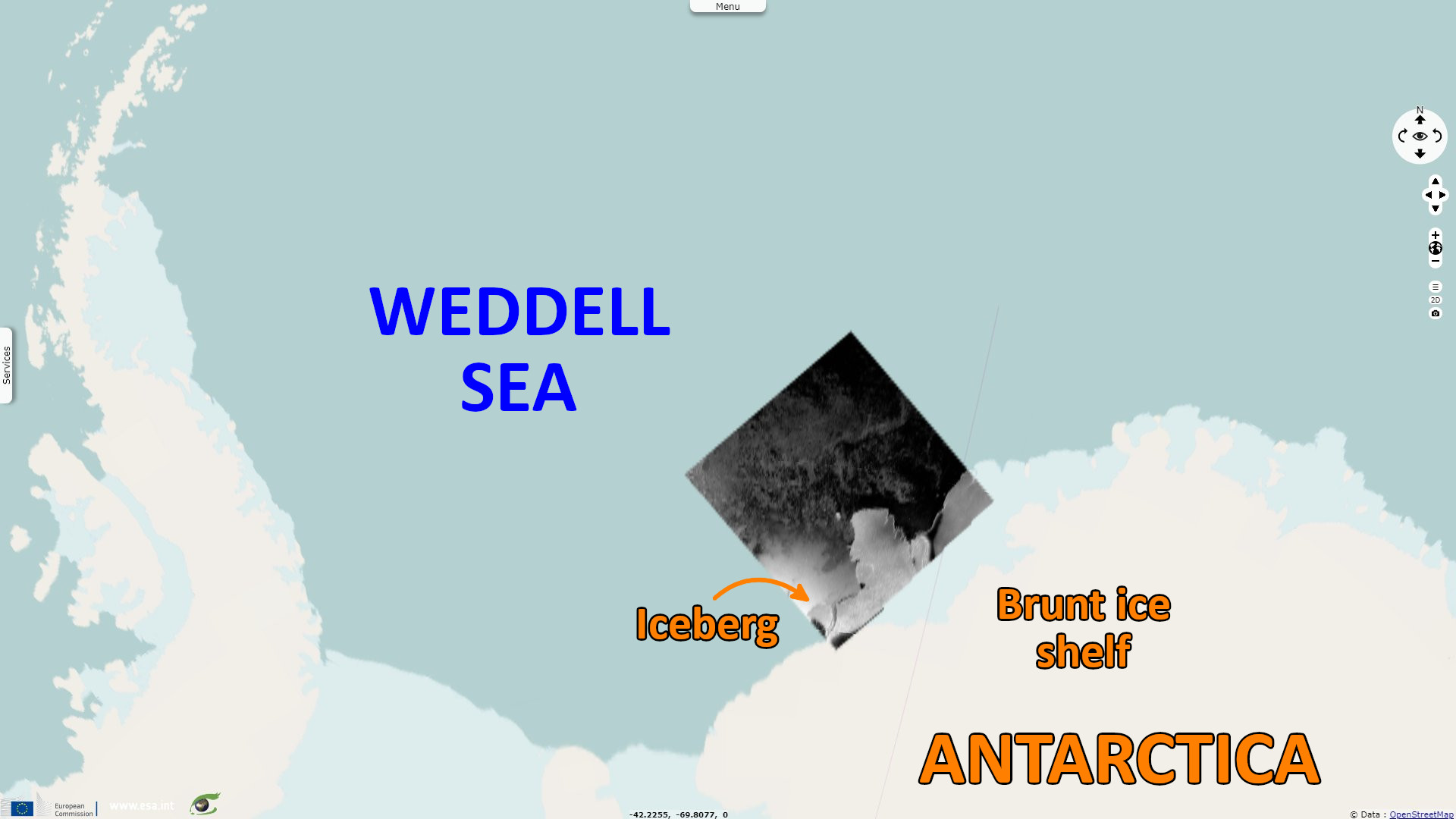Sentinels combined to show the 1550 km² iceberg calving from Brunt ice shelf, Antarctica
Sentinel-1 CSAR IW & Sentinel-3 SRAL LAND acquired on 19 January 2023
...
Sentinel-3 OLCI FR & SLSTR RBT acquired on 22 January 2023 at 09:06:21 UTC
Sentinel-3 OLCI FR, SLSTR RBT & Sentinel-2 MSI acquired on 24 January 2023
Sentinel-3 OLCI FR, SLSTR RBT & Sentinel-1 CSAR EW acquired on 25 January 2023
...
Sentinel-3 OLCI FR & SLSTR RBT acquired on 22 January 2023 at 09:06:21 UTC
Sentinel-3 OLCI FR, SLSTR RBT & Sentinel-2 MSI acquired on 24 January 2023
Sentinel-3 OLCI FR, SLSTR RBT & Sentinel-1 CSAR EW acquired on 25 January 2023
Keyword(s): Polar, cryosphere, coastal, iceberg, ice shelf, Antarctica
The British Antarctic Survey detected a new, huge iceberg was first on 22 January. "A huge iceberg (1550 km²), almost the size of Greater London, has broken off the 150 m thick Brunt Ice Shelf. It calved after cracks that have been developing naturally over the last few years extended across the entire ice shelf, causing the new iceberg to break free. This occurred on Sunday 22 January between 19.00 and 20.00 UTC during a spring tide.", indicates their news report.
"The iceberg calved when the crack known as Chasm-1 fully extended through the ice shelf. The break off is the second major calving from this area in the last two years and has taken place a decade after scientists at British Antarctic Survey (BAS) first detected growth of vast cracks in the ice.
The glaciological structure of the Brunt Ice Shelf is complex, and the impact of calving events is unpredictable. In 2016, BAS took the precaution of relocating Halley Research Station 23 km inland of Chasm-1 after it began to widen.", according to BAS.
"Professor Dame Jane Francis, Director of BAS says: 'Our glaciologists and operations teams have been anticipating this event. Measurements of the ice shelf are carried out multiple times a day using an automated network of high-precision GPS instruments that surround the station. These measure how the ice shelf is deforming and moving, and are compared to satellite images from ESA, NASA and the German satellite TerraSAR-X.'"
"Professor Dominic Hodgson, BAS glaciologist adds: 'This calving event has been expected and is part of the natural behaviour of the Brunt Ice Shelf. It is not linked to climate change. Our science and operational teams continue to monitor the ice shelf in real-time to ensure it is safe, and to maintain the delivery of the science we undertake at Halley'."
"In 2012, satellite monitoring revealed the first signs of change in a chasm (Chasm-1) that had lain dormant for at least 35 years. This change had implications for the operation of Halley VI Research Station. In the 2015-16 field season, glaciologists used ice penetrating radar technologies to ‘ground truth’ satellite images and to calculate the most likely path and speed of Chasm 1. Chasm-1 has continued to grow since 2015 and by December 2022 extended across the entire ice shelf marking the beginning of the calving event.", reminded the BAS article.
Jonathan Amos, BBC Science Correspondent reported "Recent years had seen the propagation of Chasm One accelerate, resulting now in the complete separation of a block of ice that is about 150-200 m thick."
"The calving of large bergs from a shelf structure can lead to a speed-up in the flow of the ice. Before the calving, the Brunt was flowing westwards at a rate of about 3 m / day. If it now experiences an acceleration, this could influence the behaviour of other cracks in the area."
He concludes with an historic perspective: "The calving of bergs at the forward edge of an ice shelf is a very natural behaviour. The shelf likes to maintain an equilibrium and the ejection of bergs is one way it balances the accumulation of snowfall and the input of more ice from the feeding glaciers on land. Unlike on the Antarctic Peninsula on the other side of the Weddell Sea, scientists have not detected climate changes in the Brunt region that would significantly alter the natural process described above. What is more, estimates suggest the Brunt was at its biggest extent in at least 100 years before the calving. The famous explorer Sir Ernest Shackleton recorded a much smaller shelf structure when he passed by on his ill-fated Imperial Trans-Antarctic Expedition 1914-1917. A significant calving was certainly due."









